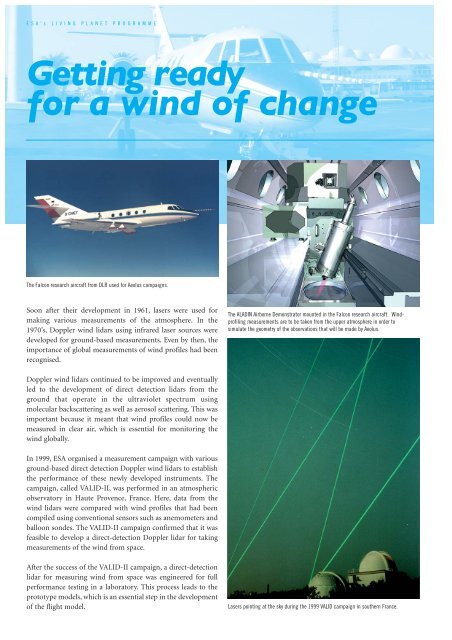ADM-Aeolus brochure (pdf) - ESA
ADM-Aeolus brochure (pdf) - ESA
ADM-Aeolus brochure (pdf) - ESA
You also want an ePaper? Increase the reach of your titles
YUMPU automatically turns print PDFs into web optimized ePapers that Google loves.
<strong>ESA</strong>’s LIVING PLANET PROGRAMME<br />
Getting ready<br />
for a wind of change<br />
The Falcon research aircraft from DLR used for <strong>Aeolus</strong> campaigns.<br />
Soon after their development in 1961, lasers were used for<br />
making various measurements of the atmosphere. In the<br />
1970’s, Doppler wind lidars using infrared laser sources were<br />
developed for ground-based measurements. Even by then, the<br />
importance of global measurements of wind profiles had been<br />
recognised.<br />
Doppler wind lidars continued to be improved and eventually<br />
led to the development of direct detection lidars from the<br />
ground that operate in the ultraviolet spectrum using<br />
molecular backscattering as well as aerosol scattering. This was<br />
important because it meant that wind profiles could now be<br />
measured in clear air, which is essential for monitoring the<br />
wind globally.<br />
In 1999, <strong>ESA</strong> organised a measurement campaign with various<br />
ground-based direct detection Doppler wind lidars to establish<br />
the performance of these newly developed instruments. The<br />
campaign, called VALID-II, was performed in an atmospheric<br />
observatory in Haute Provence, France. Here, data from the<br />
wind lidars were compared with wind profiles that had been<br />
compiled using conventional sensors such as anemometers and<br />
balloon sondes. The VALID-II campaign confirmed that it was<br />
feasible to develop a direct-detection Doppler lidar for taking<br />
measurements of the wind from space.<br />
The ALADIN Airborne Demonstrator mounted in the Falcon research aircraft. Windprofiling<br />
measurements are to be taken from the upper atmosphere in order to<br />
simulate the geometry of the observations that will be made by <strong>Aeolus</strong>.<br />
After the success of the VALID-II campaign, a direct-detection<br />
lidar for measuring wind from space was engineered for full<br />
performance testing in a laboratory. This process leads to the<br />
prototype models, which is an essential step in the development<br />
of the flight model. Lasers pointing at the sky during the 1999 VALID campaign in southern France.

















